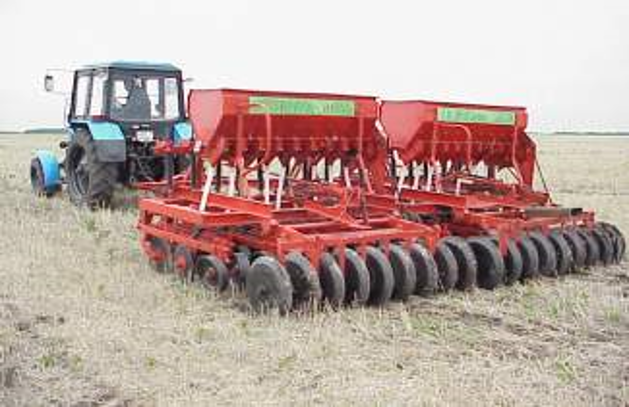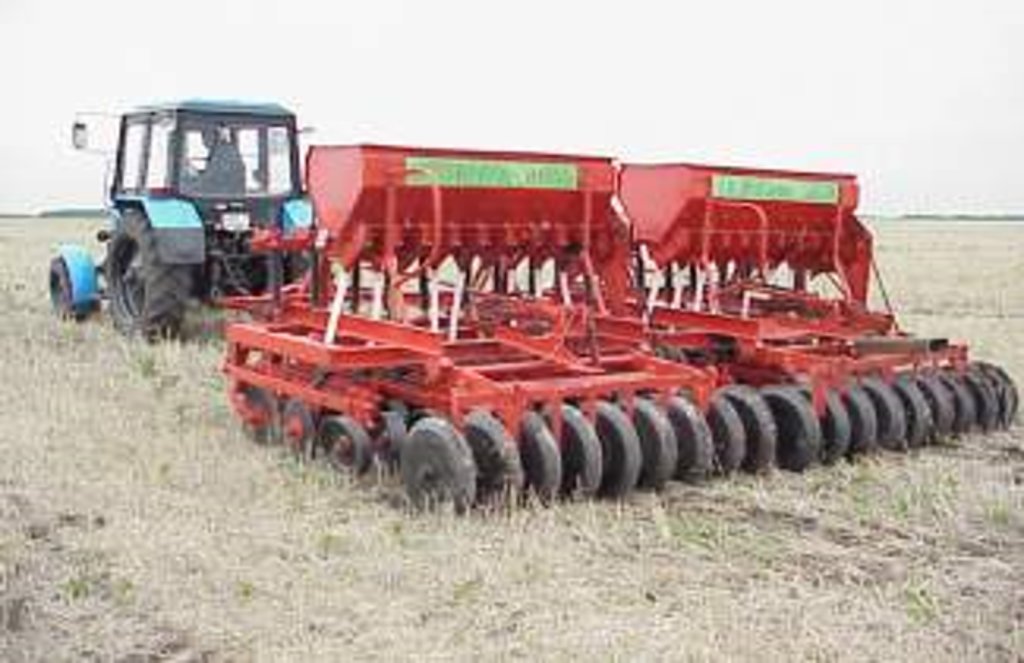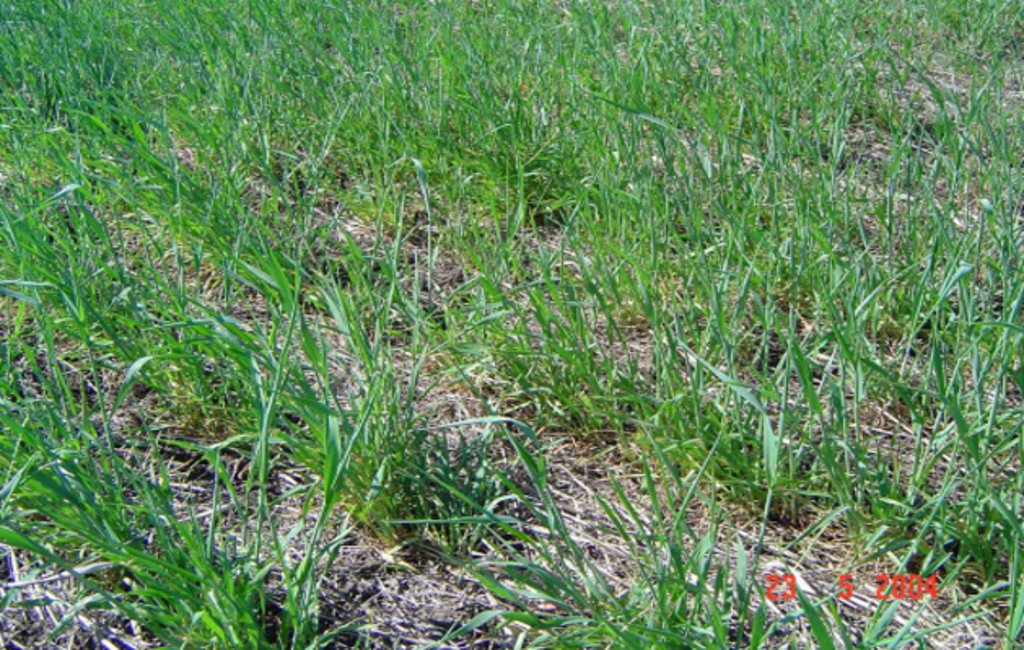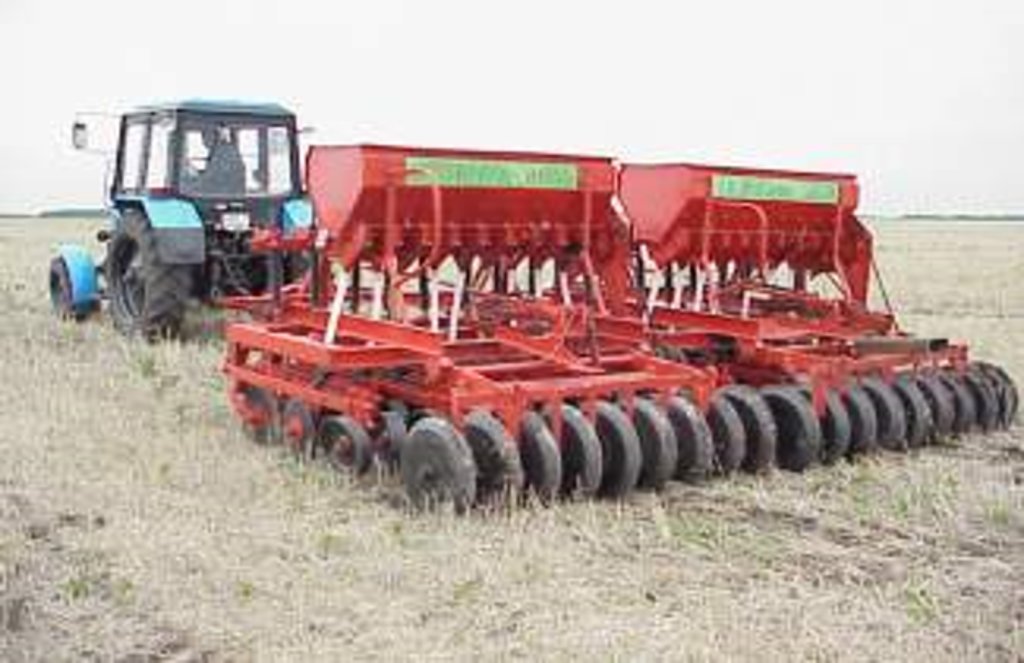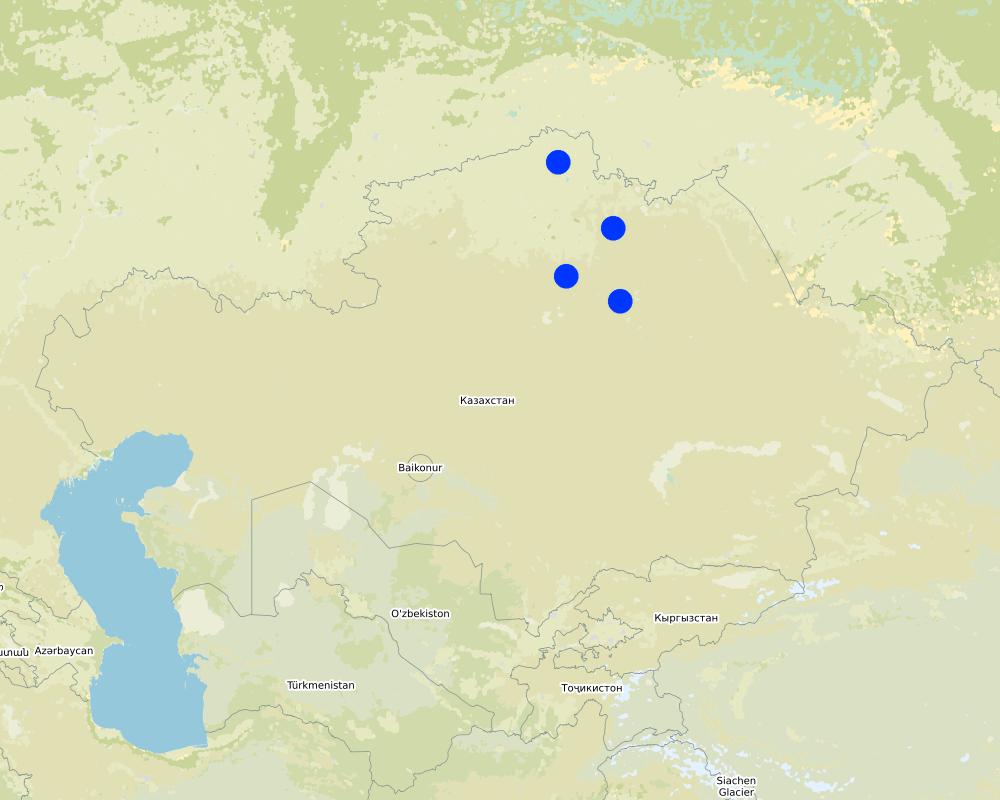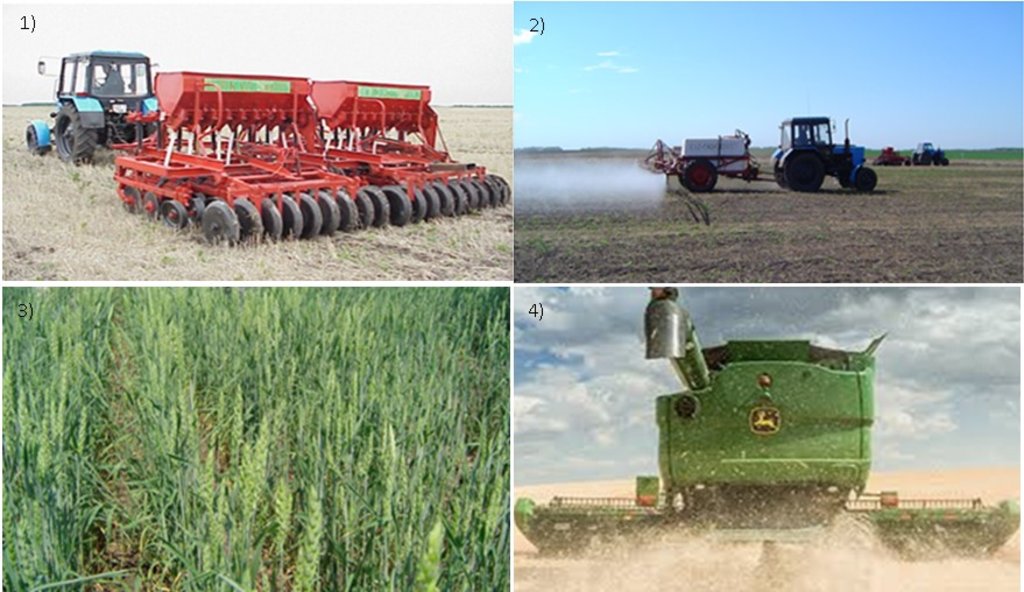Conservation Agriculture for cereal production in rainfed areas of Kazakhstan [كازاخستان]
- تاريخ الإنشاء:
- تحديث:
- جامع المعلومات: Kulyash Iskandarova
- المحرر: –
- المُراجع: Rima Mekdaschi Studer
Conservation Agriculture for cereals production in rainfed agriculture lands
technologies_5673 - كازاخستان
عرض الأقسام
توسيع الكل طي الكل1. معلومات عامة
1.2 تفاصيل الاتصال بالأشخاص الرئيسيين لمصدر المعلومات والمؤسسات المشاركة في تقييم وتوثيق التقنية
الشخص (الأشخاص) الرئيسي لمصدر المعلومات
Expert/Consultant:
Karabayev Muratbek
CIMMYT-Kazakhstan
كازاخستان
اسم المشروع الذي سهّل توثيق/تقييم التقنية (إذا كان ذلك على صلة)
Integrated natural resources management in drought-prone and salt-affected agricultural production landscapes in Central Asia and Turkey ((CACILM-2))اسم المؤسسة (المؤسسات) التي سهلت توثيق/تقييم التقنية (إذا كان ذلك على صلة)
Kazakh Research Institute for Livestock and Fodder Production (Kazakh Research Institute for Livestock and Fodder Production) - كازاخستان1.3 الشروط المتعلقة باستخدام البيانات الموثقة من خلال WOCAT
يوافق جامع المعلومات والشخص (لاشخاص) الرئيسي لمصدر المعلومات على الشروط المتعلقة باستخدام البيانات الموثقة من خلال WOCAT:
نعم
1.4 إعلان بشأن استدامة التقنية الموصوفة
هل التقنية الموصوفة هنا تمثل مشكلة فيما يتعلق بتدهور الأراضي، بحيث لا يمكن إعلانها تقنية مستدامة لإدارة الأراضي؟:
كلا
التعليقات:
The technology helps to restore degraded land
2. وصف تقنيةالإدارة المستدامي للأراضي
2.1 وصف مختصر للتقنية
تعريف التقنية:
Conservation agriculture applied in Northern Kazakhstan is based on no-tillage direct sowing of cereals into the soil permanently covered by crop residues. It contributes to reverse soil degradation, enhance water use efficiency, increase crop productivity in the rainfed lands.
2.2 وصف تفصيلي للتقنية
الوصف:
The cropping system in Northern Kazakhstan is based mainly on continuous wheat production using conventional technologies. Negative components of this system are intensive tillage, returning little organic matter to the land and monoculture. This system has led to soil degradation (wind and water erosion), soil fertility loss, boost-up of diseases, weed infestation and other problems.
Conservation Agriculture (CA) involves removing these negative components of conventional farming systems and includes three basic principles: 1) minimal soil disturbance, 2) permanent soil cover with crop residues and 3) crop rotation.
In accordance with these principles,
Conservation Agriculture technology includes 3 main operations:
1. Sowing with simultaneously soil fertilization using direct seeder.
2. Post-sowing (after 1-2 days) treatment by non-selective herbicide
3. Harvesting combined with simultaneous plant residues chopping and spreading
For comparison Conventional technology includes 7 operations:
1. Deep fall soil tillage (25 cm).
2. Early spring soil treatment.
4. Pre-sowing soil treatment.
5. Sowing with simultaneously soil fertilization using conventional seeder.
6. Selective herbicide application 2,4-Dichlorophenoxyacetic acid (2-4-D).
7. Harvesting.
The CA technology was applied in four farms in Akmola and North-Kazakhstan oblasts:
1.Farm “DARYN”, village Valikhanovo, Zharkainsky rayon, Akmola oblast, Kazakhstan.
2.Farm “Surayev”, village Vishnevka, Arshalinsky rayon, Akmola oblast, Kazakhstan.
3.Farm “Dostyk”, village Astrahanovka, Arshalinsky rayon, Akmola oblast, Kazakhstan.
4. Farm “Cherezdanov”, village Smirnovo, Akkayinskii rayon, Northern Kazakhstan oblast, Kazakhstan.
Depending on the capability of these four farms in total 330 ha agricultural land were allocated for the testing and adaptation of the technology. On each farm, field trials under equal conditions (soil, temperature, humidity, landscape, etc.) were conducted and included 2 treatments: Conventional (7 operations) and Conservation Agriculture (3 operations).
Analysis of 2002-2004 trials data demonstrated that yield of wheat and other cereals under CA technology was in average 15-25% higher in comparison with the conventional technology. The advantages of CA technology are especially evident in the years of drought (up to 40% in dry 2004 year). Economic evaluation of the technology made by two independent experts from Kazakhstan (Kazakh Research Institute for Grain Farming) and USA (Idaho State University) suggested that costs of labor, fuel, repairs and spare parts as well as machinery and equipment wearing-out under the Conservation Agriculture technologies is significantly lower as compared to those of traditional technology. In general, it is important to emphasize that the experience of the CA adaptation in North Kazakhstan helped farmers/land-users:
•To determine the appropriate level of tillage in a cropping system that is feasible with direct sowing and CA technology requirements as a potential goal.
•To retain sufficient residue on the soil surface to reduce soil erosion, enhance crop/water productivity, improve soil fertility (because of plant organic material bioprocessing in the soil) and better ensure long term, sustainable production.
•Employ economically viable, diversified crop rotations that can improve cropping system productivity and offer farmers new options to reduce risk that is extremely important for the conditions of Northern Kazakhstan relating to the area of risk farming.
The introduction of the technology for cereal production in the rainfed areas of Kazakhstan was realized within the framework of the FAO/TCP/KAZ/2801 (T) Project “Conservation Agriculture for Sustainable Crop Production in Northern Kazakhstan”, under active cooperation with counterparts: Ministry of Agriculture of the Republic of Kazakhstan (MoA RK), FAO, CIMMYT, Union of Farmers of Kazakhstan (UFK), national agriculture research organizations.
2.3 صور التقنية
2.4 فيديوهات عن التقنية
تعليقات، وصف موجز:
not available
2.5 البلد/المنطقة/المواقع التي تم تنفيذ التقنية فيها والتي يغطيها هذا التقييم
البلد:
كازاخستان
المنطقة/الولاية/المحافظة:
Northern Kazakhstan: Akmola and North Kazakhstan regions (provinces)
مزيد من التفاصيل حول الموقع:
Smirnovo village, Akkayin district, Northern Kazakhstan region; Valikhanovo village, Zharkainsk district, Akmola region; Astrahanovka village, Astrahanskyi district, Akmola region; 4) Vishnevka village, Arshalinsky district, Akmola region
حدد انتشار التقنية:
- منتشرة بالتساوي على مساحة
هل يقع موقع/مواقع التقنية في منطقة محمية بشكل دائم؟:
كلا
التعليقات:
1) Farm “Cherezdanov”, Smirnovo village, Akkayin district, Northern Kazakhstan region, located approximately 60 kilometers south of Petropavlovsk and 700 km from Astana (Nur-Sultan). The farm Head is Vyacheslav Cherezdanov.
2) Farm “Daryn”, Valikhanovo village, Zharkainsk district, Akmola region, located approximately 600 kilometers southwest of Astana (Nur-Sultan). The Head is Auezkhan Darynov.
3) Farm “Dostyk 06”, Astrahanovka village, Astrahanskyi district, Akmola region, located approximately 110 kilometers west of Astana (Nur-Sultan). The Head is Meyram Sagimbayev.
4) Farm “Surayev”, Vishnevka village, Arshalinsky district, Akmola region, located approximately 60 kilometers south of Astana (Nur-Sultan). The Head is Viktor Surayev.
Map
×2.6 تاريخ التنفيذ
اذكر سنة التنفيذ:
2002
2.7 إدخال التقنية
حدد كيف تم إدخال التقنية:
- من خلال المشاريع/ التدخلات الخارجية
التعليقات (نوع المشروع، الخ):
FAO TCP/KAZ/2801 (T) Project “Conservation Agriculture for Sustainable Crop Production in Northern Kazakhstan”
The project was initiated by UN Food and Agricultural Organization (FAO) under active cooperation with counterparts: Ministry of Agriculture of the Republic of Kazakhstan (MoA RK), FAO, CIMMYT, Union of Farmers of Kazakhstan (UFK), national agriculture research organizations. The project was aimed to testing, adaptation and introduction of Conservation Agriculture technology for cereal production in Northern Kazakhstan. At the present time the technology is applied on the area of around 3 mln ha in Northern Kazakhstan.
3. تصنيف تقنية الإدارة المستدامي للأراضي
3.1 الغرض الرئيسي ( الأغراض الرئيسية) للتقنية
- تحسين الإنتاج
- الحد من تدهور الأراضي ومنعه وعكسه
- الحفاظ على/تحسين التنوع البيولوجي
- التكيف مع تغير المناخ/الظواهر المتطرفة وآثارها
- خلق أثر اقتصادي مفيد
3.2 نوع (أنواع) استخدام الأراضي الحالية حيث يتم تطبيق التقنية
استخدامات الأراضي مختلطة ضمن نفس وحدة الأرض:
كلا

الأراضي الزراعية
- زراعة سنوية
الزراعة السنوية - حدد المحاصيل:
- الحبوب - الشعير
- الحبوب - الشوفان
- الحبوب - شيلم
- الحبوب - قمح (ربيعي)
عدد مواسم الزراعة في السنة:
- 1
هل يتم ممارسة الزراعة البينية؟:
كلا
هل تتم ممارسة تناوب المحاصيل؟:
نعم
إذا كانت الإجابة بنعم، حدد:
Crop rotations at the project farms.
(In average, spring wheat occupies 50% of lands in crop rotations)
Plot/ field1st year2nd year3rd year
#1 Wheat Barley Wheat
#2 Rye Wheat Oat
#3 Wheat Oat Wheat
#4 Barley Wheat Rye
3.3 هل تغير استخدام الأراضي نتيجة لتنفيذ التقنية؟
هل تغير استخدام الأراضي نتيجة لتنفيذ التقنية؟:
- لا (تابع مع السؤال 3.4)
استخدامات الأراضي مختلطة ضمن نفس وحدة الأرض:
كلا
3.4 إمدادات المياه
إمدادات المياه للأرض التي يتم تنفيذ التقنية عليها:
- بعلية
التعليقات:
average annual rainfall: 250 mm
3.5 مجموعةالإدارة المستدامة للأراضي التي تنتمي إليها هذه التقنية
- تحسين الغطاء الأرضي/النباتي
- الحد الأدنى من اختلال التربة
3.6 التدابير التقنية في مجال إلادارة المستدامة للأراضي

التدابير الزراعية
- A2: المادة العضوية/خصوبة التربة
- A3: معالجة سطح التربة
- A6: إدارة المخلفات
A3: التمييز بين أنظمة الحراثة:
A 3.1: لا حرث
A6:حدد إدارة المخلفات:
A 6.4:تم الاحتفاظ بها
التعليقات:
CA technology implies retention plant residues (chopped and spread) in the field. This is organic matter in huge quantities. Due to biological processing of this substance the soil fertility as well as soil quality are improved.
3.7 الأنواع الرئيسية من تدهور الأراضي التي تناولتها التقنية

تآكل التربة بالمياه
- الوزن(Wt): فقدان التربة السطحية/تآكل السطح

تآكل التربة الناتج عن الرياح
- (Et): فقدان التربة السطحية

التدهور المادي أو الفيزيائي للتربة
- (Pc) : تراص التربة

آخر
حدد:
loss of soil fertility due to wind and water erosion
3.8 منع أو حد أو عكس تدهور الأراضي
تحديد هدف التقنية فيما يتعلق بتدهور الأراضي:
- الحد من تدهور الأراضي
4. المواصفات الفنية، وأنشطة التنفيذ، والمدخلات، والتكاليف
4.1 الرسم الفني للتقنية
المواصفات الفنية (المتعلقة بالرسم الفني):
Sequence of main operations and elements of the technology implemented:
1) Direct sowing of wheat with seeder SZS 6.12 equipped with brazil disk openers and cutting discs, and simultaneous ammophos application at the rate of Р20
2) Herbicide treatment (Glyphosate 360) with sprayer OP-2000, 3.0 l/ha after wheat planting
3) Direct sowing spring wheat
4) Harvesting with chopping and overspreading of the straw
Technical specifications, dimensions, spacing of the experimental plots:
The total land area under the technology - 330 ha for 4 farms: «Cherezdanov», «Dostyk 06», «Suraev», «Daryn» (20 plots , 16.5 ha each)
1 plot - 16.5 ha (length - 702 m, width - 235 m)
Species used: wheat, barely, rye, oat. Different seed rates of spring wheat are used at the farms: from 105 kg/ha to 140 kg/ha.
المؤلف:
Muratbek Karabayev
التاريخ:
09/08/2004
4.2 معلومات عامة بخصوص حساب المدخلات والتكاليف
حدد كيفية احتساب التكاليف والمدخلات:
- حسب مساحة تنفيذ التقنية
الإشارة إلى حجم ووحدة المساحة:
330 ha
حدد العملة المستخدمة لحساب التكاليف:
- دولار أمريكي USD
اذكر متوسط تكلفة أجر العمالة المستأجرة في اليوم الواحد:
22 USD
4.3 أنشطة التأسيس
| النشاط | التوقيت (الموسم) | |
|---|---|---|
| 1. | Snow Retention | Dec-Feb |
| 2. | Herbicides (Glyphosate) Application | May |
| 3. | Direct sowing, fertilizing | May |
| 4. | Herbicide Application | June |
| 5. | Harvest and Hauling | Aug-Sep |
التعليقات:
SNOW RETENTION: By leaving stubbles on the field to improve soil moisture storage.
HAULING: Farmers in Kazakhstan have to transport harvested yield to the special Grain storage/elevator, located distantly remotely, usually it is one elevator for one district. This is transportation expenses
4.4 التكاليف والمدخلات اللازمة للتأسيس
| تحديد المدخلات | الوحدة | الكمية | التكاليف لكل وحدة | إجمالي التكاليف لكل مدخل | % من التكاليف التي يتحملها مستخدمو الأراضي | |
|---|---|---|---|---|---|---|
| العمالة | Permanent and seasonal workers | person-days | 242,7 | 22,0 | 5339,4 | |
| معدات | Fuel | liter | 5374,28 | 0,35 | 1881,0 | |
| معدات | Modification of seeders and sprayers | 2,0 | 1240,8 | 2481,6 | ||
| معدات | Machinery Depreciation (7 Unit of equipment) | 7,0 | 1427,5 | 9992,5 | 100,0 | |
| معدات | Machinery Interest (7 Unit of equipment) | 7,0 | 646,4 | 4524,8 | 100,0 | |
| المواد النباتية | Wheat Seed | kg | 40764,7 | 0,17 | 6930,0 | |
| الأسمدة والمبيدات الحيوية | Fertilizer: Ammonium Phosphate | kg | 33000,0 | 0,1 | 3300,0 | |
| الأسمدة والمبيدات الحيوية | Herbicide: Broadleaf | liter | 330,0 | 5,5 | 1815,0 | |
| الأسمدة والمبيدات الحيوية | Herbicide: Glyphosate | liter | 990,0 | 6,5 | 6435,0 | |
| غير ذلك | Land | ha | 330,0 | 12,88 | 4250,4 | 100,0 |
| إجمالي تكاليف إنشاء التقنية | 46949,7 | |||||
| إجمالي تكاليف إنشاء التقنية بالدولار الأمريكي | 46949,7 | |||||
إذا تحمل مستخدم الأرض أقل من 100% من التكاليف، حدد من قام بتغطية التكاليف المتبقية:
The contribution from land users (4 Farms) were amounted to 18 767,7 USD. The remaining costs were covered by the funds of the project FAO / TCP / KAZ / 2801 (T) Project “Conservation Agriculture for Sustainable Crop Production in Northern Kazakhstan”
التعليقات:
- The "Labor" section provides the average data on the salary costs of permanent and seasonal workers
- Total costs for establishment of the Technology per 1 ha is 142,27 USD
- In general, the stage of establishment requires more expenses, in particular for acquiring a direct seeder or modifying the traditional one. In this case the additional expenses were made for modification of local seeders and sprayers.
4.5 الصيانة/الأنشطة المتكررة
| النشاط | التوقيت/الوتيرة | |
|---|---|---|
| 1. | Snow Retention | Dec-Feb |
| 2. | Herbicides (Glyphosate) Application | May |
| 3. | Direct sowing, fertilizing | May |
| 4. | Herbicide Application | June |
| 5. | Harvest and Hauling | Aug-Sep |
4.6 التكاليف والمدخلات اللازمة للصيانة/للأنشطة المتكررة (سنويًا)
| تحديد المدخلات | الوحدة | الكمية | التكاليف لكل وحدة | إجمالي التكاليف لكل مدخل | % من التكاليف التي يتحملها مستخدمو الأراضي | |
|---|---|---|---|---|---|---|
| العمالة | Permanent and Seasonal Workers | person/days | 242,7 | 22,0 | 5339,4 | |
| معدات | Fuel | liter | 5374,28 | 0,35 | 1881,0 | |
| معدات | Equipment repairs and service | 2,0 | 1240,8 | 2481,6 | ||
| معدات | Machinery Depreciation (7 Unit of equipment) | 7,0 | 1427,5 | 9992,5 | 100,0 | |
| معدات | Machinery Interest (7 Unit of equipment) | 7,0 | 646,4 | 4524,8 | 100,0 | |
| المواد النباتية | Wheat seads | kg | 40764,7 | 0,17 | 6930,0 | |
| الأسمدة والمبيدات الحيوية | Fertilizer: Ammonium Phosphate | kg | 33000,0 | 0,1 | 3300,0 | |
| الأسمدة والمبيدات الحيوية | Herbicide: Broadleaf | liter | 330,0 | 5,5 | 1815,0 | |
| الأسمدة والمبيدات الحيوية | Herbicide: Glyphosate | liter | 825,0 | 6,5 | 5362,5 | |
| غير ذلك | Land | ha | 330,0 | 12,88 | 4250,4 | 100,0 |
| إجمالي تكاليف صيانة التقنية | 45877,2 | |||||
| إجمالي تكاليف صيانة التقنية بالدولار الأمريكي | 45877,2 | |||||
إذا تحمل مستخدم الأرض أقل من 100% من التكاليف، حدد من قام بتغطية التكاليف المتبقية:
The contribution from land users (4 Farms) amounted to 18767.7 USD. The remaining costs were covered by the funds of the project FAO / TCP / KAZ / 2801 (T) Project “Conservation Agriculture for Sustainable Crop Production in Northern Kazakhstan”
التعليقات:
The "Labor" section provides the average data on the salary costs of permanent and seasonal workers.
Total costs for maintenance of the Technology per 1 ha is 139,0 USD
The totals of establishment and maintenance costs not the same due to the difference in the rate of use of the glyphosate herbicide (3 l/ha vs 2.5 l / ha)
4.7 أهم العوامل المؤثرة على التكاليف
قدم وصفا لأهم العوامل التي تؤثر على التكاليف:
CA technology shows some clear economic advantages compared to the traditional system. Production costs for CA are slightly higher, associated primarily with the cost of glyphosate. But they are partially reimbursed by lower costs fot labor, fuel and ownership costs associated with a slight reduction in equipment use. However, additional revenue associated with the higher yields experienced for CA compensates for the higher production costs.
5. البيئة الطبيعية والبشرية
5.1 المناخ
هطول الأمطار السنوي
- < 250 مم
- 251- 500 ملم
- 501 - 750ملم
- 1,000-751 ملم
- 1,500-1,100 ملم
- 2,000-1,500 ملم
- 3,000-2,001 ملم
- 4,000-3,100 ملم
- > 4000 ملم
حدد متوسط هطول الأمطار السنوي (إذا كان معروفًا)، بالملليمتر:
250,00
المواصفات/التعليقات على هطول الأمطار:
Short growing period, low rainfall during the growing period, frequent droughts, early and late frosts
الإشارة إلى اسم محطة الأرصاد الجوية المرجعية المعنية:
“KazHydroMet” National State Organization
المنطقة المناخية الزراعية
- شبه قاحلة
Farm “Cherezdanov”, Smirnovo village, Akkayinskii rayon, Northern Kazakhstan oblast: mean annual rainfall, mm - 333,4; mean annual temperature (degrees Celsius) - +1,6;
Farm “Dostyk 06”, Astrahanovka village, Astrahanskyi rayon, Akmola oblast: mean annual rainfall, mm - 319,6; mean annual temperature (degrees Celsius) - +1,6;
Farm “Surayev”, Arshalinsky rayon, Akmola oblast: mean annual rainfall, mm - 312,8; mean annual temperature (degrees Celsius) - +2,4;
Farm “Daryn”, Valikhanovo village, Zharkainsky rayon, Akmola oblast: mean annual rainfall, mm - 253,4; mean annual temperature (degrees Celsius) - +2,5
5.2 طوبوغرافيا
متوسط الانحدارات:
- مسطح (0-2%)
- بسيط (3-5%)
- معتدل (6-10%)
- متدحرج (11-15%)
- تلال (16-30%)
- شديدة الانحدار(31-60%)
- فائقة الانحدار (>60%)
التضاريس:
- هضاب/سهول
- أثلام مرتفعة
- المنحدرات الجبلية
- منحدرات التلال
- منحدرات في السفوح
- قاع الوادي
المنطقة الارتفاعية:
- 100-0 متر فوق سطح البحر
- 500-101 متر فوق سطح البحر
- 1,000-501 متر فوق سطح البحر
- 1,500-1,001 متر فوق سطح البحر
- 2,000-1,501 متر فوق سطح البحر
- 2,500-2,100 متر فوق سطح البحر
- 3,000-2,501 متر فوق سطح البحر
- 4,000-3,001 متر فوق سطح البحر
- > 4000 متر فوق سطح البحر
وضح ما إذا كانت التقنية مطبقة على وجه التحديد في:
- غير ذات صلة
5.3 التربة
متوسط عمق التربة:
- ضحل جدًا (0-20 سم)
- ضحلة (21-50 سم)
- متوسطة العمق (51-80 سم)
- عميقة (81-120 سم)
- عميقة جدًا (> 120 سم)
قوام التربة (التربة السطحية):
- متوسط ( طميي، سلتي)
قوام التربة (> 20 سم تحت السطح):
- متوسط ( طميي، سلتي)
المواد العضوية في التربة السطحية:
- متوسطة (1-3%)
إذا كان متاحًا، قم بإرفاق وصف كامل للتربة أو تحديد المعلومات المتوفرة، على سبيل المثال نوع التربة، الرقم الهيدروجيني/ درجة حموضة التربة، قدرة التبادل الكاتيوني، النيتروجين، الملوحة وما إلى ذلك.
Soil depth on average: 1 m.
5.4 توافر المياه ونوعيتها
منسوب المياه الجوفية:
50-5 م
توافر المياه السطحية:
متوسط
نوعية المياه (غير المعالجة):
مياه الشرب سيئة (تتطلب معالجة)
تشير جودة المياه إلى:
المياه الجوفية والسطحية
هل تعتبر ملوحة الماء مشكلة؟:
كلا
هل تحدث فيضانات في المنطقة؟:
كلا
5.5 التنوع البيولوجي
تنوع الأنواع:
- متوسط
تنوع الموائل:
- متوسط
5.6 خصائص مستخدمي الأراضي الذين يطبقون التقنية
مستقر أو مرتحل:
- غير المترحل
التوجه السوقي لنظام الإنتاج:
- مختلط (كفاف/ تجاري)
- تجاري/سوق
الدخل من خارج المزرعة:
- أقل من % 10من كامل الدخل
- 10-50% من جميع الإيرادات
المستوى النسبي للثروة:
- متوسط
أفراداً أو مجموعات:
- موظف (شركة، حكومة)
مستوى المكننة:
- ميكانيكية/ مزودة بمحرك
الجنس:
- نساء
- رجال
عمر مستخدمي الأرضي:
- متوسط العمر
5.7 متوسط مساحة الأرض التي يستخدمها مستخدمو الأراضي الذين يطبقون التقنية
- < 0.5 هكتارا
- 0.5 - 1 هكتار
- 1 -2 هكتار
- 2 - 5 هكتار
- 5 - 15 هكتار
- 15 - 50 هكتار
- 50 - 100هكتار
- 500-100 هكتار
- 1,000-500 هكتار
- 10,000-1,000 هكتار
- > 10,000 هكتار
هل يعتبر هذا نطاقًا صغيرًا أو متوسطًا أو واسعا (في إشارة إلى السياق المحلي)؟:
- على نطاق متوسط
5.8 ملكية الأراضي، وحقوق استخدام الأراضي، وحقوق استخدام المياه
ملكية الارض:
- دولة
حقوق استخدام الأراضي:
- مؤجر
حقوق استخدام المياه:
- مجتمعي (منظم)
هل تعتمد حقوق استخدام الأراضي على نظام قانوني تقليدي؟:
نعم
حدد:
Land lease for 49 years
according to the Land code of the Republic of Kazakhstan
التعليقات:
Land ownership in Kazakhstan is on state and individual basis. Lands of large farms are owned by state, and farmers can use these lands only for farming purpose based on long-term agreement (rent) for up to 49 years with relevant state authorities and bodies. Smallholder farmers mostly owned agriculture lands (average size around 10 ha) individually.
5.9 الوصول إلى الخدمات والبنية التحتية
الصحة:
- ضعيف
- معتدل
- جيد
التعليم:
- ضعيف
- معتدل
- جيد
المساعدة التقنية:
- ضعيف
- معتدل
- جيد
العمل (على سبيل المثال خارج المزرعة):
- ضعيف
- معتدل
- جيد
الأسواق:
- ضعيف
- معتدل
- جيد
الطاقة:
- ضعيف
- معتدل
- جيد
الطرق والنقل:
- ضعيف
- معتدل
- جيد
مياه الشرب وخدمات الصرف الصحي:
- ضعيف
- معتدل
- جيد
الخدمات المالية:
- ضعيف
- معتدل
- جيد
6. الآثار والتصريحات الختامية
6.1 الآثار التي أظهرتها التقنية في الموقع
الآثار الاجتماعية والاقتصادية
الإنتاج
إنتاج المحاصيل
خطر فشل الإنتاج
إدارة الأراضي
الدخل والتكاليف
النفقات على المدخلات الزراعية
دخل المزرعة
عبء العمل
الآثار الاجتماعية والثقافية
الأمن الغذائي / الاكتفاء الذاتي
المعرفة بالإدارة المستدامة للأراضي/تدهور الأراضي
الآثار الايكولوجية
دورة المياه / الجريان السطحي
حصاد / جمع المياه
الجريان السطحي
التبخر
التربة
رطوبة التربة
فقدان التربة
تكون قشرة التربة السطحية/انسداد مسام التربة
تراص التربة
دورة المغذيات/إعادة الشحن
المادة العضوية في التربة/تحت الطبقة c
التنوع البيولوجي: الغطاء النباتي، الحيوانات
الأنواع المفيدة
الحد من مخاطر المناخ والكوارث
آثار الجفاف
انبعاث الكربون والغازات المسببة للاحتباس الحراري
6.2 الآثار التي أظهرتها التقنية خارج الموقع
آثار الغازات الدفيئة
6.3 تعرض التقنية وحساسيتها لتغير المناخ التدريجي والظواهر المتطرفة/الكوارث المرتبطة بالمناخ (كما يراها مستخدمو الأراضي)
تغير مناخ تدريجي
تغير مناخ تدريجي
| الموسم | زيادة أو نقصان | كيف تتعامل التقنية مع ذلك؟ | |
|---|---|---|---|
| درجة الحرارة السنوية | زيادة | جيدا | |
| درجة الحرارة الموسمية | الصيف | زيادة | جيدا |
| هطول الأمطار السنوي | انخفاض | جيدا | |
| هطول الأمطار الموسمية | الصيف | انخفاض | جيدا |
الظواهر المتطرفة / الكوارث المرتبطة بالمناخ
الكوارث الجوية
| كيف تتعامل التقنية مع ذلك؟ | |
|---|---|
| عاصفة ممطرة محلية | جيدا |
| عاصفة ثلجية محلية | جيدا |
| عاصفة رملية/ غبارية محلية | جيدا |
الكوارث المناخية
| كيف تتعامل التقنية مع ذلك؟ | |
|---|---|
| جفاف | جيدا |
الكوارث الهيدرولوجية
| كيف تتعامل التقنية مع ذلك؟ | |
|---|---|
| فيضان مفاجئ | جيدا |
6.4 تحليل التكلفة والعائد
كيف يمكن مقارنة العوائد نسبة لتكاليف الإنشاء (من وجهة نظر مستخدمي الأراضي)؟
عوائد قصيرة الأجل:
محايد/متوازن
عوائد طويلة الأجل:
إيجابي
كيف تتم مقارنة العوائدمع كلفة الصيانة/التكاليف المتكررة (من وجهة نظر مستخدمي الأراضي)؟
عوائد قصيرة الأجل:
إيجابي قليلا
عوائد طويلة الأجل:
ايجابي جدا
6.5 اعتماد التقنية
- 11-50%
إذا كان متاحًا، قم بتحديد الكمية (عدد الأسر المعيشية و/أو المساحةالمغطاة):
about 3 mln ha under Conservation Agriculture in Kazakhstan now
من بين جميع الذين تبنوا التقنية، كم عدد الذين فعلوا ذلك بشكل تلقائي، أي دون تلقي أي حوافز مادية/مدفوعات؟:
- 10-0%
التعليقات:
Kazakhstan is now included among the top ten countries with the largest areas under CA in the world (Source: FAOSTAT).
6.6 التكيف
هل تم تعديل التقنية مؤخرًا لتتكيف مع الظروف المتغيرة؟:
كلا
6.7 نقاط القوة / المزايا / الفرص التي توفرها التقنية
| نقاط القوة/ المزايا/ الفرص من وجهة نظر مستخدمي الأراضي |
|---|
| A special advantage of Conservation Agriculture is observed in extremely dry conditions. It allows to consider this technology as water-conserving, which is critical for risky farming area in Kazakhstan. |
| Conservation Agriculture is not inferior to traditional technologies and is competitive in the regional cereal production system and promising given their role in soil fertility recovery, cost reduction, increase in labor productivity and positive effect on the environment. |
| The wide-scale use of Conservation Agriculture in Kazakhstan, shift of farms to modern cropping systems are realistic and promising. |
| نقاط القوة/ المزايا/ الفرص من وجهة نظر جامع المعلومات أو غيره من الاشخاص الرئيسيين لمصدر المعلومات |
|---|
| Based on the data on yield, ecological, soil and agronomic parameters and economic analysis, the Conservation Agriculture can be considered as effective and promising for the region. It will allow for farmers to switch to modern farming systems based on diversified crop production, minimal soil treatment, stubble retention, and direct seeding. |
| The modified local seeders, in general, performed well and can be used under production conditions. The possibility to locally produce direct seeders and well-established herbicide and fertilizer production suggest feasible wide-scale application of CA technology for crop production in the country. |
| Under current conditions, it is extremely important to intensify collaboration between national agricultural systems and international organizations and research centers. They actively use their large international expertise, modern technologies, rich genetic pool to facilitate a rapid integration of a country’s agrarian sector into the world system. |
6.8 نقاط ضعف / مساوىء / مخاطر التقنية وسبل التغلب عليها
| نقاط الضعف/ المساوىء/ المخاطر من وجهة نظر مستخدم الأراضي | كيف يمكن التغلب عليها؟ |
|---|---|
| High costs at the 1st stage of technology implementation | State support programs or land user cooperation needed |
| Weed control problems | Weed control is one aspect that needs further research. Herbicides are costly in Kazakhstan, especially when compared to depressed grain prices. Options for weed control with different weed spectra and these different conditions must be available. One of the ways to combat is the crop rotation. Potential for more diversified systems in northern Kazakhstan exists. Policy emphasis should be placed on market development for alternative crops. |
| نقاط الضعف/ المساوىء/ المخاطر من وجهة نظر جامع المعلومات أو غيره من الاشخاص الرئيسيين لمصدر المعلومات | كيف يمكن التغلب عليها؟ |
|---|---|
| Equipment availability for resource-poor farmers | There are many inexpensive models of direct seeders and other equipment for CA in the world market. Farmers need in marketing services, technical consultations. Subsidizing purchase of CA equipment by government can help farmers to advance the process of CA adoption in country and region. |
| Delayed effect (it takes time to get all the benefits of the technology) | Provision of long-term low interest loans |
| The problem of farmers' awareness of technology, its features and benefits | Awareness needs to be raised |
7. المراجع والروابط
7.1 طرق جمع/مصادر المعلومات
- زيارات ميدانية، مسوحات ميدانية
4 visits, field days
- مقابلات مع مستخدمي الأراضي
4 interviews with land users
- مقابلات مع المتخصصين/الخبراء في الإدارة المستدامة للأراضي
2 experts
- التجميع من التقارير والوثائق الأخرى الموجودة
متى تم تجميع البيانات (ميدانيا)؟:
2012
7.2 المراجع للمنشورات المتاحة
العنوان، المؤلف، السنة، النظام القياسي الدولي لترقيم الكتب ISBN:
1.Karabaev M., Vasko I., Matyushkov M., Bektemirov A., Kenzhebekov A., Bakhman T., Friedrich T., Makus L., Morgunov A., Darinov A., Sagimbaev M., Suraev V., Perezdanov V ., Rodionov A., Wall P. Zero-processing and direct sowing technologies for the cultivation of grain crops in Northern Kazakhstan. 2005. FAO-SIMMIT, 64 p. (in Russian)
العنوان، المؤلف، السنة، النظام القياسي الدولي لترقيم الكتب ISBN:
2.Shpigun S., Karabayev M.No-till and direct seeding technologies for cereals in North Kazakhstan. - Practical recommendations for farmers. Astana, Kazakhstan, 2007, 15 p.
العنوان، المؤلف، السنة، النظام القياسي الدولي لترقيم الكتب ISBN:
3.Karabayev M., Yuschenko N., Akramkhanov A., and Shpigun S.Forage crops production in dry areas with an allowance for ecological risks. - Methods of seeding and growing of perennial and annual grasses. Astana, Kazakhstan, 2007, 112 p.
العنوان، المؤلف، السنة، النظام القياسي الدولي لترقيم الكتب ISBN:
4.CIMMYT Wheat Improvement Program for Kazakhstan. Together in 21st Century. - 2008, CIMMYT, 56 p.
العنوان، المؤلف، السنة، النظام القياسي الدولي لترقيم الكتب ISBN:
5.Yushenko N., Iskakov Z., Karabayev M., Shpigun S., Yushenko D., Shaushekov T., Baitassov A. Perennial grasses cropping in abandoned lands of Central Kazakhstan based on Conservation Agriculture. – Drylands Management, World Bank-GEF-MOEP Kazakhstan, 2008, p.38-43.
العنوان، المؤلف، السنة، النظام القياسي الدولي لترقيم الكتب ISBN:
6.No-Till with Soil Cover and Crop Rotation: A Basis for Policy Support to Conservation Agriculture for Sustainable Production Intensification. – Proceedings of the International Consultation Conference, 8-10 July, 2009, Astana-Shortandy, Kazakhstan. CIMMYT, FAO, Ministry of Agriculture, Kazakhstan, 2009, p. 350.
العنوان، المؤلف، السنة، النظام القياسي الدولي لترقيم الكتب ISBN:
7.Commonwealth Agricultural Bureaux International (CABI). 2011. Climate Change and Crop Production. Oxfordshire, UK: CABI, 292 p.
العنوان، المؤلف، السنة، النظام القياسي الدولي لترقيم الكتب ISBN:
8.FAO (Food and Agriculture Organization of the United Nations). 2011. Save and Grow: A Policymaker’s Guide to the Sustainable Intensification of Smallholder Crop Production. Rome, Italy: FAO.
العنوان، المؤلف، السنة، النظام القياسي الدولي لترقيم الكتب ISBN:
9.Ospanbayev Zh., Koishibayev M., Karabayev M., Zhapayev R., Bedoshvili D., Zhunusov K. 2010. Winter wheat direct seeding technology on rainfed lands. Recommendations for farmers, Almaty, Kazakhstan, 13 p.
العنوان، المؤلف، السنة، النظام القياسي الدولي لترقيم الكتب ISBN:
10.Karabayev M., Ushenko N., Baitassov A., Ushenko D., Ishmukhanbetov S. 2011. Conservation agriculture for hayfields and pastures under agricultural landscapes of Central Kazakhstan // INAT-AGRO, GEF, UNDP, CIMMYT. Astana, Kazakhstan, 39 p.
العنوان، المؤلف، السنة، النظام القياسي الدولي لترقيم الكتب ISBN:
11.Ushenko N., Ushenko D., Baitassov A. 2011. Adaptation of no till and direct seeding of cereals in agricultural landscapes of Central Kazakhstan // CIMMYT, ACP, Astana, Kazakhstan, 22 p.
العنوان، المؤلف، السنة، النظام القياسي الدولي لترقيم الكتب ISBN:
12.Advancement and impact of conservation agriculture/no-till technology adoption in Kazakhstan. FAO Investment Centre, Information Note, December 6, 2012
العنوان، المؤلف، السنة، النظام القياسي الدولي لترقيم الكتب ISBN:
13.Karabayev M., P.Wall., K.Sayre, R.Zhapayev, A.Morgounov, V.Dvurechenski, N.Yushenko, T.Friedrich, T.Fillecia, A.Jumabayeva, M.Guadagni. Adoption of Conservation Agriculture in Kazakhstan // Soil-Water Journal. 2013, Vol. 2, # 2, p. 2003-2006.
العنوان، المؤلف، السنة، النظام القياسي الدولي لترقيم الكتب ISBN:
14.Zhapayev R., K.Iskandarova, M.Karabayev, K.Toderich. Ecological testing of the sorghum genotypes in South-East Kazakhstan // Agroecological bases of improvement the productivity and sustainability of Agriculture in the XXI century. 2013, Kazakhstan, p. 124-127.
العنوان، المؤلف، السنة، النظام القياسي الدولي لترقيم الكتب ISBN:
15.Karabayev M., V.Dvurechenski, P.Wall, K.Sayre, T.Friedrich, N.Yushenko, Zh.Ospanbayev, R.Zhapayev, A.Morgounov, A.Darinov, A.Nazarenko, E.Gossen, T.Fillecia, M.Guadagni. Conservation Agriculture in Kazakhstan // CIMMYT-Kazakhstan, 2013, 32 p.
العنوان، المؤلف، السنة، النظام القياسي الدولي لترقيم الكتب ISBN:
16.Karabayev M., A.Morgounov, P.Wall, K.Sayre, Y.Zelenskiy, R.Zhapayev, V.Dvurechenskii, A.Akhmetova, T.Friedrich, T.Fileccia, M.Guadagni. Conservation Agriculture and breeding for sustainable wheat production in Kazakhstan // Journal of Bahri Dagdas Crop Research, 2014, (1-2), 50-53 p.
العنوان، المؤلف، السنة، النظام القياسي الدولي لترقيم الكتب ISBN:
17.Nurbekov A., A.Akramkhanov, J.Lamers, A.Kassam, T.Friedrich, R.Gupta, H.Muminjanov, M.Karabayev, D.Sydyk, J.Turok, M.Bekenov. Conservation Agriculture in Central Asia (chapter) // Conservation Agriculture. Global prospects and challenges. CABI (CAB Int.), 2014, UK-USA, p.223-248.
العنوان، المؤلف، السنة، النظام القياسي الدولي لترقيم الكتب ISBN:
18.Karabayev M., A.Morgounov, H.-J.Braun, P.Wall, K.Sayre, Yu.Zelenskiy, R.Zhapayev, A.Akhmetova, V.Dvurechenskii, K.Iskandarova, T.Friedrich, T.Fileccia, M.Guadagni. Effective approaches to wheat improvement in Kazakhstan: Breeding and Conservation Agriculture // Journal of Agricultural Science and Technology, USA, 2014, v.4, #10, p.761-765.
العنوان، المؤلف، السنة، النظام القياسي الدولي لترقيم الكتب ISBN:
19.Goddard T., Basch G., Derpsh R., Hongwen L., Jin H., Karabayev M., Moriya K., Peiretti R., Smith H. Institutional and policy support for CA uptake // Advances in Conservation Agriculture, Volume 1: Systems and Science, Burleigh Dodds Science Publishing, Cambridge, UK, 2020, (ISBN: 978 1 78676 264 1; www.bdspublishing.com), 52 p.
7.3 روابط للمعلومات ذات الصلة على الإنترنت
العنوان/الوصف:
No-Till: A Climate Smart Agriculture Solution for Kazakhstan (World Bank)
عنوان الرابط URL:
http://www.worldbank.org/en/results/2013/08/08/no-till-climate-smart-agriculture-solution-for-kazakhstan
7.4 تعليقات عامة
Open access to the Global Database on Sustainable Land Management give opportunities to all interested parties, namely farmers, scientists, decision-makers to use the technologies and experience that has been accumulated and tested in practice in regions and countries with similar climatic conditions. This opportunity is especially valuable for regions affected of climate change, in particular, prone to drought and salinization. It is necessary to disseminate more widely the information on the availability and possibilities of using this database in the target audience.
الروابط والوحدات المواضيعية
توسيع الكل طي الكلالروابط
لا يوجد روابط
الوحدات المواضيعية
لا يوجد وحدات مواضيعية


